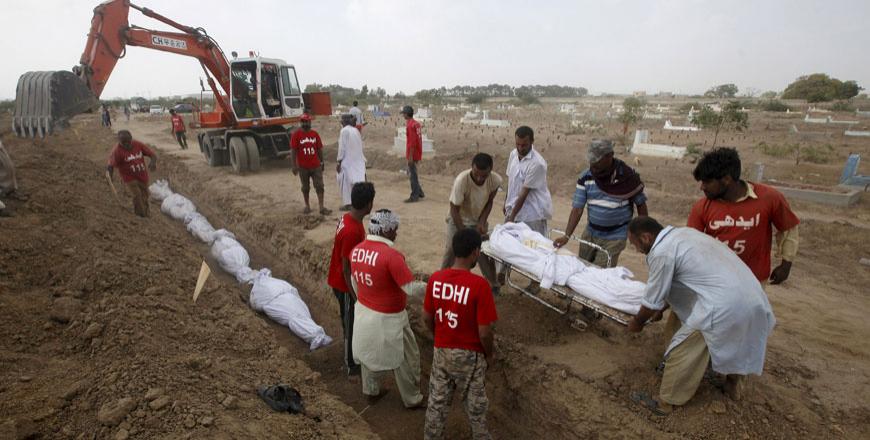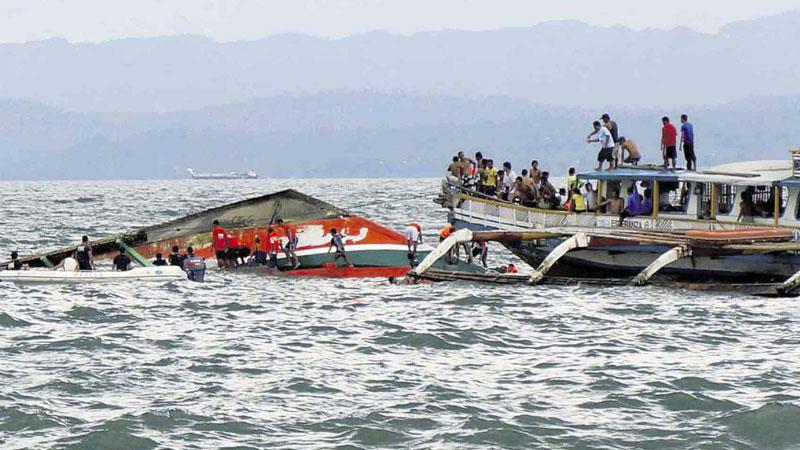
It’s a fear that stalks furtively, the fear of dying alone, unloved and unmourned. Blended in this are worries about physical helplessness, about the indignities of the processes of death. But above all, dying alone seems an indictment of how we have lived, as if the universe itself scrawled ‘could do better’ across a report card untainted by anything of note. As if we never mattered.
That is why, two weeks after the killer heatwave in Karachi left some 1,233 dead, many are still wondering about the 261 ‘unclaimed bodies’. Who were they, these people only Edhi wept over? Were they once distinguishable in a crush of humanity, these dead who are now a series of numbers in a communal grave? Did they ever matter, even to themselves?
The search for answers takes me to the Edhi morgue.
Set in the sprawling Edhi complex in Karachi’s stolidly middle-income Federal B Area, the morgue is the only one in the city that allows even the indigent the right to dignity in death. The beige marble of the cavernous, 18×24 main hall offers respite from the late afternoon sun and white energy savers dispel the gloam. Three fans suspended from the false ceiling lazily swish around swarms of flies as well as eddies of cool and hot air. And every once in a while, when you’re least expecting it, rises the stench of putrefying bodies.
It’s hard to describe this smell: a strange composition of the stewing juices of decomposing flesh, unwashed human bodies and rotting flowers, laced with traces of formaldehyde. Faint but perceptible are base notes of blood, piss, sweat and shit — reminders that this too was once human, alive. It’s less a scent than a physical being, which clings to and then wafts off the clothes, the bodies of the Edhi staff, pirouettes on the beams of sunlight slashing the marbled floor and seemingly vapourises in the afternoon heat.
Ghulam Hussain has been working here for the last 10 years and we settle down for a chat on the marbled ledge that runs around the room. “It was so hot, you couldn’t sit here; the heat seared through the marble,” he says of the weekend of June 21. “We buried some 300 unidentified people that week, of which 39 were subsequently claimed by relatives.”
We’re interrupted by three women in abayas, stifling sobs; they are here to identify a body. Hussain skims through their paperwork, there’s a rapid-fire exchange in Sindhi. I hear “gunshot victim” and try to quell my curiosity by focusing on two pink spots on the floor (guava juice? bloodstains?) and then the light goes out. A volunteer appears with an emergency light and the three disappear, with their trailing abayas, into the cold storage area to the left.
So who were the 261 they buried? Vagrants? Heroin addicts? Professional beggars? The detritus of society?
Hussain recoils visibly. “No,” he says emphatically. “Some were heroin addicts — between 30 to 35 in total — but the rest were healthy, well-built, well-nourished people.” He seems to grapple for a word, a description that will convince me. “Kaam karne wale log the [they were working class people],” he concludes miserably, as he scans my face to see if I’ve understood.
Before I can cross-question him, the room erupts in wails. The women are back and for the next few moments, Hussain is transfixed. Does it still affect him? “I am a human being,” he says simply. “Doctors, policemen can’t afford to get emotional; it would affect their work. But we…” It’s an ethos Abdul Sattar Edhi personifies. A printed ‘appeal’ in Urdu hangs on the wall at the Edhi office near Mereweather Tower.
Employees and volunteers are reminded that Edhi himself begs for alms on the streets and any person who steps into Edhi offices to donate deserves to be treated with courtesy and respect. “If you can’t do so, please quit your job. This is God’s work; it will continue without you as well.” Under the shadow of this veiled threat, Edhi staff engage in the business side of their work: a man shuffles in, carrying four bright blue polyethene bags. “Kaffan hain [are these shrouds]?” asks Anwar Kazmi, who also functions as Edhi’s spokesperson. The man nods: “Cotton hai [it’s cotton cloth]” These men are intimately familiar with the modalities of death — Kazmi gives me a detailed account of how much graves cost in which part of the city — but, as Hussain shows, they have yet to lose their compassion.
So if less than 15 per cent of the unidentified dead were vagrants, beggars and addicts, why weren’t the other bodies claimed? One of the rumours swilling around the city puts forward economic reasons: meteoric demand fuelled a price hike and the cost of a grave rose from between Rs5,000 and Rs10,000 to as much as Rs50,000 in some cases. Those who couldn’t afford these rates were forced to step back and let Edhi bury their dead. Kazmi finds the idea plausible: “We received more than 10 times the amount of dead people we usually do so it is possible that the high cost of graves pushed people to leave bodies unclaimed.”
But Hussain disagrees vehemently. “It’s very difficult to identify decomposing bodies, even for relatives,” he says, as he leads me to the front desk of the morgue, which doubles as an office. As per procedure, an unidentified body is kept in the Edhi morgue for three days before burial. Apart from the standard autopsy-type details (gunshot/stab wound etc), the Edhi staff also makes a note of the precinct the body was discovered in and takes a photograph of the deceased before burial. These details, along with an assigned death number, are inscribed by hand in fat registers and help claimants identify their loved ones.
The first calls on June 21 started coming in around 11am, when people began fainting across the city. By the time the day ended, there were 280 bodies and Karachi’s administration had collapsed under their combined weight.
Hussain hands me a two-inch thick stack of 4×8 colour photographs, held together with a flimsy rubber band. All are headshots of people in advanced stages of decomposition. As the bodies of the heatwave victims putrefied, they released gases that contorted facial features. Hussain quietly watches me sort through the unending stream of bulbous eyes, protruding, mottled tongues and bloated, blackish-grey faces with thin trickles of blackish-maroon blood. There are faces where the flesh seems to be hanging on the face by a gravity-defying miracle, the skin stretched taut over eye sockets that could have been hewn from stone. There are others where the facial muscles lost the battle against the dead person’s canines and the premolars, the moment frozen in a grotesque grimace. And there are yet others whose features are indistinguishable behind thick plastic sheets.
“Some of the bodies were so decomposed, we had to wrap them in plastic just so we could bury them,” he explains softly. “It’s very hard to identify even your loved ones when they’re in this state.”
According to Kazmi, the first calls on June 21 started coming in around 11am, when people began fainting across the city. By the time the day ended, there were 280 bodies and Karachi’s administration had collapsed under their combined weight. The hospitals were overwhelmed, the city ran out of ambulances, the morgues were filled to capacity and yet the dead kept coming.
The city’s Samaritans are rightly credited for pulling themselves up by their bootstraps and rescuing a city in crisis: doctors at government hospitals pulled 72-hour stints, aid workers pushed themselves to exhaustion and beyond, citizens flooded hospitals with bottled water, ice blocks, juice and biscuits. But the suffocating blanket of heat that enveloped Karachi worked against everyone, undermined everyone’s effort. There were people who collapsed on the streets, Hussain reminds me, and by the time the bodies were picked up by an ambulance and taken to a hospital, pronounced dead and then ferried to a morgue, a couple of hours had passed. There were long queues everywhere: for ambulances, at hospitals, at the morgues, even for burial. “From the time a body arrived at our doorstep, there was a three to five-hour wait before we could put it in storage,” he says.
There was a two-hour wait for even those that brought their relatives to be bathed prior to the funeral. And all this while, the bodies baked in ambulances in the heat. “Do you wonder that people couldn’t recognise their relatives after such advanced decomposition? Some bodies were so bad, we couldn’t even wait the stipulated three-day period before burial,” he grimaces.
We return to the main hall and shortly after, the gunshot victim is wheeled out for bathing, the sheet slipping to show the exit point of the bullet on his forehead.
Now Hussain takes me inside the cold storage area, which comprises two 20×30 rooms. Three-tiered shelves run across both lengths of the first room, with neatly stacked bodies on them, while an empty rack stands in the centre. It’s sparsely populated today: just seven or eight bodies. The built capacity for the unit is 200 — Hussain says they get between 30 and 40 bodies per day on average.
But in the last week of June, the morgue had between 300 and 350 corpses here. “We took out this central stretcher to make space,” he tells me, as he gestures around the room, which is used by families who need to delay burials. “We just put sheets on the floor and began to pack the bodies in — there were three rows there under the AC, another row extending from this corner — there were just so many bodies.”
We walk further down, into the second room, where the corpses professionally trussed up by hospital staff give way to those casually draped with shrouds with ‘Edhi’ stamped across them in blood red. Even in death, the indigent are a separate social category unto themselves. Hussain points towards the exposed feet of one. “The addicts have this weather-beaten colour; just look at his long and dirty toenails, the matted hair and beard. The others are unidentified too but they don’t look like this.”
We return to the main hall and shortly after, the gunshot victim is wheeled out for bathing, the sheet slipping to show the exit point of the bullet on his forehead. A male relative comes up and asks sotto voce about the wound. “Don’t worry; we’ll clean him up well for the funeral,” Hussain murmurs, before he turns to talk to two Pathan boys carrying a child wrapped in a prayer mat. Yet another wants to know what the charges for bathing a five-day-old girl will be. “Don’t worry about that; just get her bathed. You don’t even need to get a receipt,” he says.
I’m suddenly desperate to leave so I make my excuses. Unlike everyone I’ve ever interviewed, Hussain doesn’t bother asking me when this article will be printed. As I walk towards my car, I’m hoping the afternoon sun will sterilise my being and remove the smell — that smell. After 10 minutes in the airconditioned car, I can’t smell it anymore and I relax.
Except the smell doesn’t really dissipate. It just lodges itself at the back of my throat, to rise again when I am safe at home and about to sip my first cup of tea.
Wednesday 8 July 2015
http://tns.thenews.com.pk/261-unclaimed-bodies-after-karachi-heatwave/




